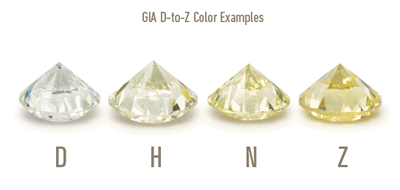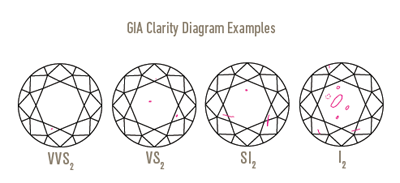Previously we outlined four basic steps to purchasing a diamond. Today we will expand on our explanation of the 4Cs – the four factors that determine a diamond’s value.
Color
The diamond color evaluation of most gem-quality diamonds is based on the absence of color. A chemically pure and structurally perfect diamond has no hue, and consequently, a higher value. GIA evaluates the degree of colorlessness by comparing the diamond being inspected, under controlled lighting and precise viewing conditions, to masterstones of established color values. Many of these color distinctions are so subtle that they are invisible to the untrained eye; however, these distinctions make a very big difference in diamond quality and price. Color is assigned a grade based on the GIA D-to-Z Color Grading Scale, ranging from colorless (D) to light yellow or brown (Z).
Clarity
Natural diamonds are the result of carbon exposed to tremendous heat and pressure deep in the earth. This process can result in a variety of internal characteristics called ‘inclusions’ and external characteristics called ‘blemishes.’ Evaluating diamond clarity involves determining the number, size, relief, nature, and position of these characteristics, as well as how these affect the overall appearance of the stone. While no diamond is perfectly pure, the closer it comes, the higher its value. Many inclusions and blemishes are too tiny to be seen by anyone other than a trained diamond grader. To the naked eye, a VS1 and an SI2 diamond may look exactly the same, but these diamonds are quite different in terms of overall quality. This is why expert and accurate assessment of clarity is extremely important. The GIA Clarity Scale includes eleven grades ranging from Flawless to I3.
Cut
Diamonds are highly sought after for their brilliance and intense sparkle. The quality of diamond cut is crucial to the diamond’s final beauty and value. Of the 4Cs, it is the most complex and technically difficult to assess. In assigning a cut grade for the standard round brilliant diamond, GIA evaluates seven components.
The first three consider the diamond’s overall face-up appearance: brightness, internal and external white light reflected from a diamond; fire, the scattering of white light into all the colors of the rainbow; and scintillation, the sparkle a diamond produces and the pattern of light and dark areas caused by reflections within the diamond.
The remaining four assess the diamond’s design and craftsmanship: weight ratio, the weight of the diamond relative to its diameter; girdle thickness, which affects its durability; symmetry of its facet arrangement; and quality of polish.
The GIA Cut Grading Scale for standard round brilliant diamonds in the D-to-Z color range provides five grades ranging from Excellent to Poor.
Carat Weight
Carat weight is the measurement of how much a diamond weighs. A metric carat is defined as 200 milligrams. Each carat can be subdivided into 100 ‘points.’ This allows very precise measurements to the hundredth decimal place. The weight of a diamond below one carat can be described by its points alone. For example, a diamond that weighs 0.25 carats could also be referred to as a ‘twenty-five pointer.’ Diamond weights greater than one carat are expressed in carats and decimals. A 1.08 carat diamond would be described as ‘one point oh eight carats.’ All else being equal, diamond price increases with carat weight, because larger diamonds are more rare and more desirable. But two diamonds of equal carat weight can have very different values (and prices) depending on the other three factors within the 4Cs: clarity, color, and cut.
GIA created the 4Cs as a universal method for establishing diamond quality. The various factors that make up the diamond buying decision are personal, however, by educating yourself on the 4C of Diamond Quality, you’re bound to find the perfect diamond to fit your needs.


